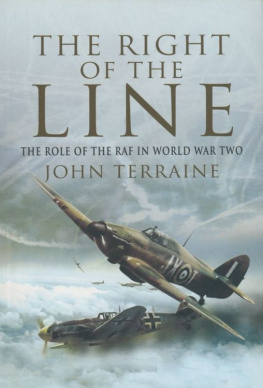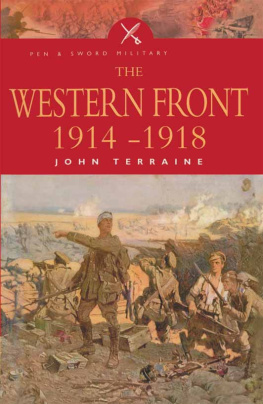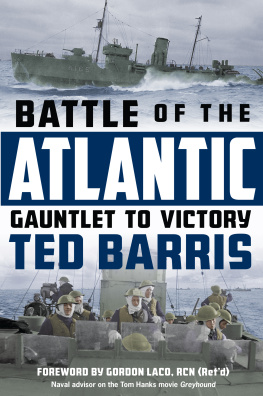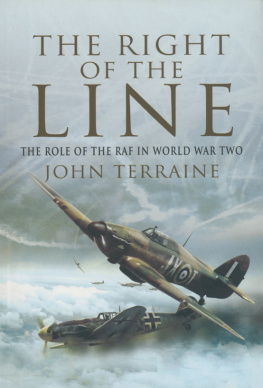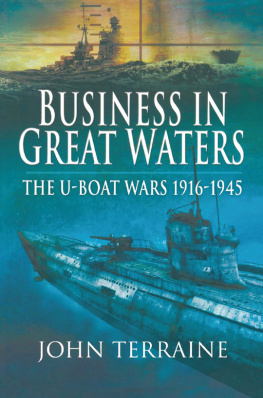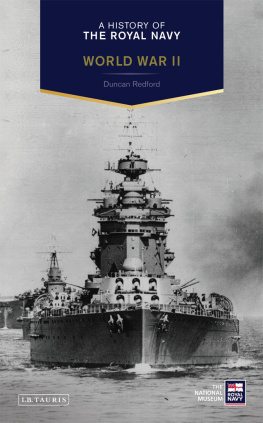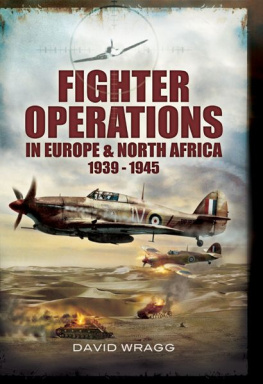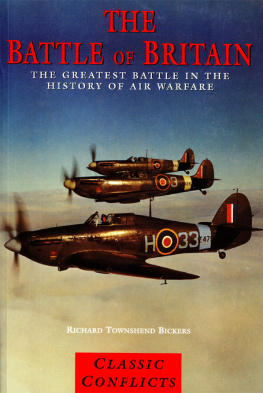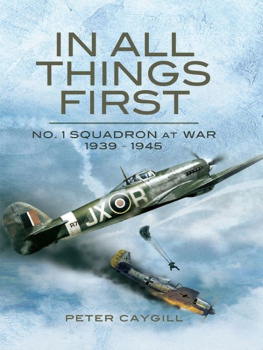The Right of the Line
By the same author
MONS: THE RETREAT TO VICTORY (1960)
DOUGLAS HAIG: tHE EDUCATED SOLDIER (1963)
THE WESTERN FRONT (1964)
GENERAL JACKS DIARY (1964)
THE GREAT WAR: AN ILLUSTRATED HISTORY (1965)
THE LIFE AND TIMES OF LORD MOUNTBATTEN (1968, reissued 1980)
IMPACTS OF WAR 1914 AND 1918 (1970)
THE MIGHTY CONTINENT (1974)
TRAFALGAR (1976)
THE ROAD TO PASSCHENDAELE (1977)
TO WIN A WAR (1978)
THE SMOKE AND THE FIRE (1980)
WHITE HEAT: THE NEW WARFARE 191418 (1982)
The Right of the
Line
The Role of the RAF in World War Two
John Terraine
It was entitled to hold, and did hold, the right of the
line in the great struggle for human freedom.
J.M. Spaight: Air Historical Branch Monograph, The
Expansion of the RAF, 19341939)

Pen & Sword
MILITARY
First published in 1985 by Hodder and Stoughton Ltd
Reprinted in this format in 2010 by
Pen & Sword Military
an imprint of
Pen & Sword Books Ltd
47 Church Street
Barnsley
South Yorkshire S70 2AS
Copyright John Terraine, 1985, 2010
ISBN 978 1 84884 192 5
The right of John Terraine to be identified as
author of this work has been asserted by him in accordance
with the Copyright, Designs and Patents Act 1988
A CIP catalogue record for this book is
available from the British Library
All rights reserved. No part of this book may be reproduced or transmitted
in any form or by any means, electronic or mechanical including
photocopying, recording or by any information storage and retrieval
system, without permission from the Publisher in writing.
Printed and bound in England
by the MPG Books Group
Pen & Sword Books Ltd incorporates the imprints of
Pen & Sword Aviation, Pen & Sword Maritime, Pen & Sword Military,
Wharncliffe Local History, Pen & Sword Select,
Pen & Sword Military Classics and Leo Cooper,
Remember When, Seaforth Publishing and Frontline Publishing
For a complete list of Pen & Sword titles please contact
PEN & SWORD BOOKS LIMITED
47 Church Street, Barnsley, South Yorkshire, S70 2AS, England
E-mail: enquiries@pen-and-sword.co.uk
Website: www.pen-and-sword.co.uk
Contents
PART I:
THE PREPARATION
Qui desiderat pacem, praeparet bellum |
PART II:
THE TEST
The battle is the pay-off |
PART III:
THE STRAIN
The only plan is to persevere. |
THE BATTLE OF BRITAIN
a few thousand airmen |
THE BATTLE OF THE ATLANTIC (I)
Anxiety supreme |
THE STRATEGIC AIR OFFENSIVE (I)
The leading element in bringing about our victory |
PART IV:
THE VICTORY
The Air must hold the ring |
THE MEDITERRANEAN
Air warfare in its own right |
THE BATTLE OF THE ATLANTIC (II)
the dominating factor all through the war |
THE STRATEGIC AIR OFFENSIVE (II)
they are sowing the wind |
VICTORY IN EUROPE
the highest degree of intimacy |
Illustration Contents
Between pages 124 and 125
Sir Edward Ellington, GCB, CMG, CBE
Sir Cyril Newall, GCB, OM, GCMG, CBE, AM
Gloster Gladiator
Avro Anson
Short Sunderland
Supermarine Spitfire
Lockheed Hudson
Bristol Blenheim
Sir Edgar Ludlow-Hewitt, GCB, GBE, CMG, DSO, MC
Armstrong Whitworth Whitley
Between pages 220 and 221
Sir Arthur Barratt, KCB, CB, CMG, MC
Westland Lysander
Sir Hugh Dowding, GCB, GCVO, CMG
Filter Command temporary filter room
Station Operations Room
Sir Douglas Bader, CBE, DSO, DFC, with Canadian pilots
Sir Keith Park, GCB, KBE, MC, DFC
Sir Trafford L. Leigh-Mallory, KCB, CB, DSO
Between pages 316 and 317
Sir Frederick Bowhill, GBE, KCB, CB, CMG, DSO
Sir Philip Joubert de la Fert, KCB, CB, CMG, DSO
U-boat attacked
Photo-Reconnaissance
Consolidated Liberator
Sir John Slessor, GCB, DSO, MC
Between pages 412 and 413
Sir Richard Peirse, KCB, CB, DSO, AFC, with HM Queen Elizabeth
Sir Arthur Harris, GCB, OBE, AFC
Vickers Wellington
De Havilland Mosquito
Avro Lancaster
Wing Commander Guy Gibson, VC, DSO, DFC
RAF aircrew member interrogated
Between pages 508 and 509
Sir Arthur Longmore, GCB, DSO
Middle East dust-storm
Sir Arthur Tedder, GCB, Sir Charles Portal, KG, GCB, OM, DSO, MC, Sir Harry Broadhurst, GCB, KBE, DSO, DFC, AFC and Sir Arthur Coningham, KCB, KBE, CB, DSO, MC, DFC, AFC
Sir Arthur Tedder in Tripolitania
Hawker Hurricane IIDs
Bristol Beaufighter
Lieut-Gen Sir Bernard Montgomery with Sir Arthur Coningham
Luftwaffe graveyard
Between pages 604 and 605
Final briefing
Stand Down night
Airfield bombing
Hawker Typhoon
North American Mustang
Normandy landing-strip
Handley Page Halifax destroyed
Dresden 1945
Acknowledgments
By courtesy of the Royal Air Force Museum, Hendon
Reproduced with the permission of the Controller of Her Majestys Stationery Office
By courtesy of the Imperial War Museum
By courtesy of the BBC Hulton Picture Library
By courtesy of Harleyford Publications
By courtesy of Air Commodore Voyce
By courtesy of Mr David Irving
At the Battle of Crcy, on August 26, 1346, the English Army under King Edward III faced apparently hopeless odds. A hard fight, with every possibility of disaster, was at hand. When the king drew up his army, it was to his eldest son, the 16-year-old Black Prince, that Edward gave the place of honour and greatest danger, commanding the vanguard on the right of the line. The battle was hard indeed, with the Black Princes division bearing the brunt of it throughout. The English won, and the boy prince won his spurs, the supreme accolade of chivalry. It is from those distant times that the right of the line has come to mean, in battle, the place of greatest danger the vanguard and in ceremony the place of honour. Thus, when the Army is on parade, it is the Cavalry (whose traditions go back to the age of chivalry) which forms on the right unless the Royal Horse Artillery is present, in which case the horse Gunners claim the post of honour. When the three Services parade together, the Royal Navy, as the senior Service, takes the right, and the Royal Air Force, as the junior, takes the left. But in this book it is argued that in the war in Europe between 1939 and 1945 the RAF was, in effect, the vanguard, holding for much of the time the place of honour on the right of the line, as the Black Prince and his men did at Crcy.
This argument will no doubt be considered odd by a number of people, because even now, in the 1980s, so much modern military history continues to be written two-dimensionally, that is to say, from the point of view of the land and sea forces only. And indeed, in World War I, when air warfare made its dbut, it was the armies and navies which continued to play the overwhelmingly larger part. In World War II the terms of reference were quite different; the Air rle was always significant, often dominant. In the first half of 1940 the German Air Force ruled the skies of Europe; it is possible that its ten Panzer divisions would have enabled the Army to win the Battle of France without the aid of the Luftwaffe
Next page
